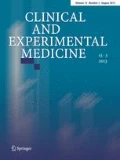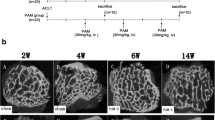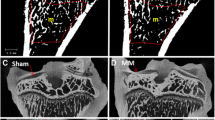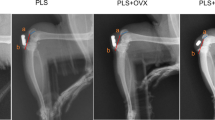Abstract
To evaluate the effects of alendronate (ALN) on the subchondral bone quality and cartilage degeneration in the early phase of experimental model of osteoarthritis after anterior cruciate ligament transaction (ACLT). Thirty male adult healthy Japanese white rabbits after right ACLT or sham operation were divided into three groups (n = 10 per group): Sham; ACLT + ALN [after ACLT, the rabbits were treated with ALN daily starting from 4 days after surgery (10 μg/kg/d subcutaneously)]; and ACLT + NS group (after ACLT, the rabbits were injected saline as a placebo). At 60 days postsurgery, specimens from the affected knees were harvested. Histological analysis (HE and Safranin-O staining) as well as Mankin score were carried out to assess the cartilage degradation. BMP-2 and MMP-13 immunohistochemistry were also performed to demonstrate the alterations of cartilage molecular metabolism. Subchondral bone quality was evaluated by bone mineral density (BMD) and microstructure histomorphometry assay. For bone mineral density evaluation, 1/4 distal femurs, medial and lateral regions of femoral condylus were scanned with dual X-ray absorptiometry to assess the subchondral bone mass. Giemsa, von Kossa stain, and fluorescence technique for undecalcified bone section were carried out to examine the morphometry of the subchondral trabecular bone and subchondral plate. Histological and Mankin score analyses displayed that ALN treatment markedly reduced cartilage lesions and delayed the cartilage degeneration in OA joints. Immunohistochemistry assay further indicated that this cartilage-protective role of ALN was associated with elevating BMP-2 while inhibiting MMP-13 expression. BMD assessment demonstrated that ALN treatment significantly suppressed subchondral bone resorption. The results from histomorphometry assay of subchondral bone revealed that ALN treatment markedly increased the percent trabecular area (BV/TV), trabecular thickness (Tb.Th), and trabecular number (Tb.N). Moreover, both thickness and the porosity of the subchondral plate in ACLT + ALN group presented significantly higher than that in ACLT + NS group, while no significant difference was found between ACLT + ALN and Sham group. ALN plays an important role in cartilage protection in OA joints that is associated with the improvement of subchondral bone quality through reduction of subchondral bone resorption. ALN could be potentially used as a disease-modifying strategy to limit the progression of OA.




Similar content being viewed by others
References
Hayami T, Pickarski M, Zhuo Y, Wesolowski GA, Rodan GA, le Duong T (2006) Characterization of articular cartilage and subchondral bone changes in the rat anterior cruciate ligament transection and meniscectomized models of osteoarthritis. Bone 38(2):234–243
Behets C, Williams JM, Chappard D, Devogelaer JP, Manicourt DH (2004) Effects of calcitonin on subchondral trabecular bone changes and on osteoarthritic cartilage lesions after acute anterior cruciate ligament deficiency. J Bone Miner Res 19(11):1821–1826
Karsdal MA, Byrjalsen I, Henriksen K, Riis BJ, Lau EM, Arnold M, Christiansen C (2010) The effect of oral salmon calcitonin delivered with 5-CNAC on bone and cartilage degradation in osteoarthritic patients: a 14-day randomized study. Osteoarthritis Cartilage 18(2):150–159
Goldring MB, Goldring SR (2010) Articular cartilage and subchondral bone in the pathogenesis of osteoarthritis. Ann N Y Acad Sci 1192:230–237
Muehleman C, Green J, Williams JM, Kuettner KE, Thonar EJ, Sumner DR (2002) The effect of bone remodeling inhibition by zoledronic acid in an animal model of cartilage matrix damage. Osteoarthritis Cartilage 10(3):226–233
Hayami T, Pickarski M, Wesolowski GA, McLane J, Bone A, Destefano J et al (2004) The role of subchondral bone remodeling in osteoarthritis: reduction of cartilage degeneration and prevention of osteophyte formation by alendronate in the rat anterior cruciate ligament transection model. Arthritis Rheum 50(4):1193–1206
Dong QR, Chen XY (2007) Experimental study on biomechanical changes of subchondral bone in osteoarthritis. China J Trauma 23(5):386–389
Carbone LD, Nevitt MC, Wildy K, Barrow KD, Harris F, Felson D et al (2004) The relationship of antiresorptive drug use to structural findings and symptoms of knee osteoarthritis. Arthritis Rheum 50(11):3516–3525
Ding M, Danielsen CC, Hvid I (2008) The effects of bone remodeling inhibition by alendronate on three-dimensional microarchitecture of subchondral bone tissues in guinea pig primary osteoarthrosis. Calcif Tissue Int 82(1):77–86
Corrado A, Santoro N, Cantatore FP (2007) Extra-skeletal effects of bisphosphonates. Joint Bone Spine 74(1):32–38
Watts NB, Diab DL (2010) Long-term use of bisphosphonates in osteoporosis. J Clin Endocrinol Metab 95(4):1555–1565
Corrado A, Cantatore FP (2005) The bisphosponates: chemical characteristics, skeletal biological effects and extra-skeletal effects. Reumatismo 57(3):142–153
Stresing V, Daubiné F, Benzaid I, Mönkkönen H, Clézardin P (2007) Bisphosphonates in cancer therapy. Cancer Lett 257(1):16–35
Asikoğlu M, Ozguney I, Ozcan I, Orumlu O, Guneri T, Koseoğlu K et al (2008) The absorption of (99 m) Tc-alendronate given by rectal route in rabbits. Pharm Dev Technol 13(3):213–220
Reagan-Shaw S, Nihal M, Ahmad N (2008) Dose translation from animal to human studies revisited. FASEB J 22(3):659–661
Center for Drug Evaluation and Research, Center for Biologics Evaluation and Research (2002) Estimating the safe starting dose in clinical trials for therapeutics in adult healthy volunteers. U.S. Food and Drug Administration Rockville, Maryland, USA
Armstrong S, Read R, Ghosh P (1994) The effects of intraarticular hyaluronan on cartilage and subchondral bone changes in an ovine model of early osteoarthritis. J Rheumatol 21(4):680–688
Wang SX, Laverty S, Dumitriu M, Plaas A, Grynpas MD (2007) The effects of glucosamine hydrochloride on subchondral bone changes in an animal model of osteoarthritis. Arthritis Rheum 56(5):1537–1548
Sniekers YH, Intema F, Lafeber FP, van Osch GJ, van Leeuwen JP, Weinans H et al (2008) A role for subchondral bone changes in the process of osteoarthritis; a micro-CT study of two canine models. BMC Musculoskelet Disord 9:20
Goldring MB, Goldring SR (2007) Osteoarthritis. J Cell Physiol 213(3):626–634
Bobinac D, Spanjol J, Zoricic S, Maric I (2003) Changes in articular cartilage and subchondral bone histomorphometry in osteoarthritic knee joints in humans. Bone 32(3):284–290
Patel V, Issever AS, Burghardt A, Laib A, Ries M, Majumdar S (2003) MicroCT evaluation of normal and osteoarthritic bone structure in human knee specimens. J Orthop Res 21(1):6–13
Kirvick DL, Pijamowski GJ, Schaeffer DJ (1994) Three-dimensional kinematics of the intact and cranial cruciate ligament-deficient stifle of dogs. J Biomech 27(1):77–87
Lorenz H, Richter W (2006) Osteoarthritis: cellular and molecular changes in degenerating cartilage. Prog Histochem Cytochem 40(3):135–163
Konttinen YT, Salo T, Hanemaaijer R, Valleala H, Sorsa T, Sutinen M et al (1999) Collagenase-3 MMP-13/and its activators in rheumatoid arthritis: localization in the pannus-hard tissue junction and inhibition by alendronate. Matrix Biol 18(4):401–412
Fernandes JC, Martel-Pelletier J, Lascau-Coman V, Moldovan F, Jovanovic D, Raynauld JP et al (1998) Collagenase-1 and collagenase-3 synthesis in normal and early experimental osteoarthritic canine cartilage: an immunohistochemical study. J Rheumatol 25(8):1585–1594
Yoon BS, Lyons KM (2004) Multiple functions of BMPs in chondrogenesis. J Cell Biochem 93(1):93–103
Fischer L, Boland G, Tuan RS (2002) Wnt-3A enhances bone morphogenetic protein-2-mediated chondrogenesis of murine C3H10T1/2 mesenchymal cells. J Biol Chem 277(34):30870–30878
Gomes RR Jr, Joshi SS, Farach-Carson MC, Carson DD (2006) Ribozyme-mediated perlecan knockdown impairs chondrogenic differentiation of C3H10T1/2 fibroblasts. Differentiation 74(1):53–63
Izzo MW, Pucci B, Tuan RS, Hall DJ (2002) Gene expression profiling following BMP-2 induction of mesenchymal chondrogenesis in vitro. Osteoarthritis Cartilage 10(1):23–33
Nakase T, Miyaji T, Tomita T, Kaneko M, Kuriyama K, Myoui A et al (2003) Localization of bone morphogenetic protein-2 in human osteoarthritic cartilage and osteophyte. Osteoarthritis Cartilage 11(4):278–284
Wan Mei, Cao Xu (2005) BMP signaling in skeletal development. Biochem Biophys Res Commun 328(3):651–657
Muraoka T, Hagino H, Okano T, Enokida M, Teshima R (2007) Role of subchondral bone in osteoarthritis development: a comparative study of two strains of guinea pigs with and without spontaneously occurring osteoarthritis. Arthritis Rheum 56(10):3366–3374
Van Beek ER, Löwik CW, Papapoulos SE (2002) Bisphosphonates suppress bone resorption by a direct effect on early osteoclast precursors without affecting the osteoclastogenic capacity of osteogenic cells: The role of protein geranylgeranylation in the action of nitrogen-containing bisphosphonates on osteoclast precursors. Bone 30(1):64–70
Hofstaetter JG, Wang J, Yan J, Glimcher MJ (2009) The effects of alendronate in the treatment of experimental osteonecrosis of the hip in adult rabbits. Osteoarthritis Cartilage 17(3):362–370
Jones MD, Tran CW, Li G, Maksymowych WP, Zernicke RF, Doschak MR (2010) In vivo microfocal computed tomography and micro-magnetic resonance imaging evaluation of antiresorptive and antiinflammatory drugs as preventive treatments of osteoarthritis in the rat. Arthritis Rheum 62(9):2726–2735
Neogi T, Nevitt MC, Ensrud KE, Bauer D, Felson DT (2008) The effect of alendronate on progression of spinal osteophytes and disc-space narrowing. Ann Rheum Dis 67(10):1427–1430
Conflict of interest
None.
Author information
Authors and Affiliations
Corresponding author
Rights and permissions
About this article
Cite this article
Zhang, L., Hu, H., Tian, F. et al. Enhancement of subchondral bone quality by alendronate administration for the reduction of cartilage degeneration in the early phase of experimental osteoarthritis. Clin Exp Med 11, 235–243 (2011). https://doi.org/10.1007/s10238-011-0131-z
Received:
Accepted:
Published:
Issue Date:
DOI: https://doi.org/10.1007/s10238-011-0131-z




